You are correct. I don’t usually do recruiting posts on my blog, however, I am guessing that my blog readers are people who might be interested in working with me. I joined Clear Measure a couple of months ago, which is a company started by Jeffrey Palermo and Mark Stavrou. Primarily based in Austin, we are starting to build a pocket of developers in Northeast Ohio. Our team up here is currently remote, but we are hoping to get enough people to merit some suburban office space for our team.
Let me know if you’re in the Northeast Ohio area and want to play buzzword bingo with this card:
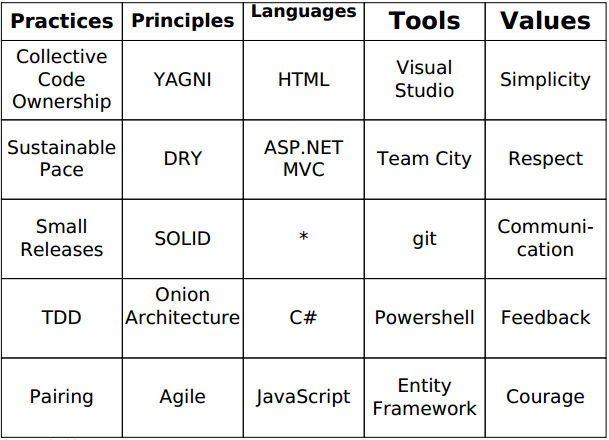
We all love buzzword bingo! Right? right?
You can always check here for Clear Measure’s current openings. Even when we don’t have a listed position open, contact me anyway, because I firmly believe that a company should always be hiring. The best people don’t come along every day. That’s how I ended up working with Todd Ropog and Kevin Kuebler years ago. They were the right people to join NimblePros.
As software developers, we have to make a lot of assumptions about things. It goes with the territory, however, we try to avoid making assumptions whenever we can. One of the values that we hold up is Communication, and that means that we need to communicate with our users. June 2014 is Assumption Driven Coding month according to the 2014 Software Craftsmanship Calendar Anti-Patterns edition.
The calendar (as always) takes a more visual approach to this software development issue.
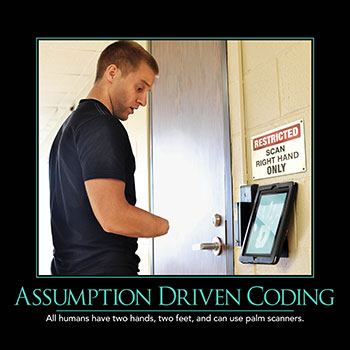
Obviously, we’re supposed to notice that Eric is missing a hand, so he cannot use this newly installed palm scanner. Whoever decided to put in this new interface should have thought of a backup system for Eric or used a different authorization mechanism.
If we step back and think of this in terms of software, we’re talking about making an assumption about our users, data, or how interaction with the system will happen. An example of this would be assuming that your users “all use the start menu”, “all search for programs”, “all use the quick launch bar”, or “all use the desktop”. Each of those is an assumption that Microsoft could make when developing its next version of Windows. Each of those assumptions would be a bad one. Heck, even assuming that I named all of the possibilities already is a really bad assumption. What if someone uses “Run” or PowerShell?
When we’re writing our software, we take a lot of guesses about how the users will use our systems. Don’t! As you’re building, watch them use it. See how they use the system. Ask the user to perform their daily routine in the new software and see what they do. Ask them some questions. And make sure that you check different types of users. Sure, you will not catch every case, but you can avoid a lot of headaches. You might not even have realized that certain users would use the feature you’re building if you don’t ask.
Let’s focus on avoiding this issue for the rest of June.
SPOILER ALERT: Eric has both a right hand and a left hand… This photo is fake.
I started my career as a software developer, because I love computers and I love building things. Building software, no matter the type of involvement, is an experience worth working toward. There are few things that can provide as much joy in such a short amount of time than seeing the text you’ve written come alive. In the last 5 years of my software development career, however, I’ve been leading teams of developers rather than just typing the lines of code that go into the software. Working with a team and building great things together is something I love regardless of the type of contribution I am making.
Now that I am transitioning back (at least for a time) into a primarily development role, I want to take some time and reflect on that change. I have enjoyed all of the work that I have done in my career, and I look forward to many more years building great things with great people.
I will never stop writing code. It’s too much fun to give up completely, but I also love people and working with people. For that reason, I enjoy leading teams of developers as well. I’ve spent these past 5 years trying to improve my leadership, not just for my own benefit, but for the benefit of my teams and the software we create. As many of you know, I blog so that I can share what I’ve learned with everyone (including my future self). Let’s talk about leadership.
Know Your Team
As a leader, it’s important that you know your team’s strengths as well as their weaknesses. This is not exactly a radical idea, but it’s one that I’ve seen ignored far too often. Every member of your team has goals, opinions, preferences, etc. They’re people. If you don’t know anything about them, you’re not leading your team. The best experiences I’ve had as a leader are always when I am communicating and soliciting feedback and ideas from everyone involved.
I make a point of getting to know my team. I make sure to lighten the mood, so I can meet the professionals as well as the people they are. If I know that certain people have tendencies toward certain things, that allows me to lead them better. It’s my job to make sure that they’re doing their job well and are happy about it.
A good friend of mine, Steve Smith, recently took on the role of CTO of Falafel Software, and I was chatting with him about that new role. He was commenting about getting to know his team and having discussions with them. I suggested he spend an hour or two pair programming with everyone he’ll be working with. This gives him the chance to talk with them and also learn how they like to work. It comes with a couple of very important benefits: it lets Steve write some code and it also lets him learn about the projects.
Know Your Projects
One of the most frustrating things as a developer is having to constantly explain and re-explain a project to a manager. Don’t be that guy. Make sure you know the project. You’re involved. Sure, you need to talk and ask about how things are going, but you should understand what’s being done. You’re not there to tell people what to do. You’re there to help people get those things done.
If you need to sit down and pair with your team, do it! Sit with the designers and help them design. Sit with the developers and help them code. Work with the team. You’re a part of the team.
When I am leading a team, I am with the team. I’m only in my office when I need a quiet space. The rest of my time, I am sitting right next to the team. If I roll my chair back, I’m bumping into a developer or a designer. That’s my ideal situation. When anything happens in the project, I need to at least be aware about it, and constantly pestering my team for status updates is not an appropriate way to do that. It wastes their time and reiterates that my time is more valuable than theirs (completely false).
Solicit Feedback
Clearly, before I make a decision, it’s a good idea to make sure that the team has a chance to weigh in on things. When you are a leader, it is likely not a democracy. Make sure you know that and make sure the team knows that. If a decision I make will impact the team, I at least alert them to it before the decision is made. This gives the chance for cries of outrage. More often, I prefer to actually have a quick discussion before making my decision.
One topic that comes up all too often is physical versus digital kanban boards. This often has to do with the circumstances of the project. Obviously if everyone involved in the project is in the same room, a physical kanban board has a lot of benefits, but if you’ve got a single remote user, you’ll lean the other way. I’ve had a few developers with strong opinions one way or the other, so I try to accommodate when I can. I know which to use for each project because of the developers who are on them, because I get to know my team.
Asking for feedback allows the team involvement in the decisions and gives them some stake in things. Make sure you’re listening and taking their suggestions to hear. I know that I never know the best approach from the start. I chose my team, because they’re smart and can help me make the right choices. Often the right choice is based on the team, so you really should ask the team.
Identify Leaders
As a leader, you need to help other leaders become better leaders. Often leadership qualities are on your team. That’s great for you! Let them take on some leadership. Give them the chance to lead some discussions, meetings, projects, etc. It will help them (and the team) to build great things. Sharing responsibilities with others will let you focus more, and will let them grow as leaders. You’ll need peers to help you lead others and people to cover for you when you’re busy or out of town.
Your team is often better at leading than you (or they) might expect. A leader who has never had the chance to lead may not know they can. If you can identify and grow leadership in your team, you will have empowered your team to make good decisions. The more your team can do on their own, the more you (and the entire team) are able to accomplish. Build more. Build better. Build the leadership in your team. It’s there already. You just need to find it and grow it.
Lead the Team
Yes, this also sounds kind of silly to mention here, but I am serious. There is a big difference between leading and directing. If you’re leading, you’re out front blazing a trail. If you’re directing, managing, or even guiding, you don’t have to be out front. When you’re leading a team, you’re setting examples. You’re doing things the right way (whatever that is for your project). You’re not cutting corners or doing a sloppy job. It’s your job to not only help, but to make sure that everyone else can follow in your footsteps to achieve success.
How you lead a team is extremely important. If you cut corners, your team will as well. If you have a sour attitude about the project, that will spread. If you’re lethargic and bored by the project, you won’t be seeing an interested, engaged team. Be the team you want your team to be. If you don’t you can’t expect any better from anyone else. This doesn’t mean you need to be the best developer, designer, tester, copy-editor, or anything else. You just need to be willing to put forth good, positive effort. You’ll be amazed at the results. When I do that right with a project, I am always impressed with how the whole teams steps up to every challenge. Whenever I’ve cut a corner, I see it repeated. It’s just not worth doing.
Set an example. Be a leader to emulate. Stay positive. Keep things moving smoothly. That is your job. Leading is hard. Doing it right is harder, but it’s very worth it. If you do it right, your team will do amazing work that will have you in awe. With that said, I’d like to thank all of the developers and designers who have ever been on my teams. I was glad to have every one of you on my teams, and you did fantastic work. (You all knew that already though!) We all achieve some great things! Now it’s my turn again!
I am just about to finish up my second month on the Clear Measure team, and I am still very impressed with what this team has built considering how young the company is. I’ve known Jeffrey Palermo, one of Clear Measure’s founders, for plenty of years, and I decided to jump at the chance to work with him and his team. It is an opportunity that I could not pass on.
Role Change
Many developers who have worked with me in the past are excited to learn that I am now getting to write a lot more code than I did before, since I’ve stepped out of a leadership position and have taken on a Principal Software Engineer role with Clear Measure.
I am looking forward to the chance to delve back into the world of coding more. I’ve been able to write quite a bit of code while leading my teams, but this will give me the chance to get back to what I love. I’d been looking for a chance to make this change back to development for a while. I don’t expect that anyone can keep me permanently out of a leadership role, but I am in the industry for the development.
I’ve been leading development teams for Steve Smith and Michelle Smith for quite a few years, while we were running NimblePros and while we were Telerik Services. Easily the most difficult decision I’ve made in my entire career has been to part ways with them, primarily because it seems like such a big mistake to stop working with them. I am sure that this is not the last time I will work with those two. In fact, I am already discussing some plans for a side project with Steve.
Diving in Head First
I’ve been extremely impressed with the speed at which I was able to start writing code with Clear Measure. Many others are impressed to learn that I was building and running a solution in my first hour at Clear Measure. That’s just awesome.
Additionally, since Clear Measure had just started the project, I was able to get things running the way I wanted them to. The project is running under continuous integration and is a derivative of this Iteration Zero project. Letting the new guy run loose like that was something I was very happy about. In fact, the entire company seems to be based around the idea that people will make good choices when given the chance. I agree!
Two Dimensional Brendan
Now that I am working remotely, my team primarily sees me through a webcam. That’s certainly a change! I am a big proponent of having a team that is co-located, but for the right team you make exceptions. I think Clear Measure considers me the exception, and I consider them the exception. I’m just glad that we can agree on the situation.
I went from being in spaces like these:
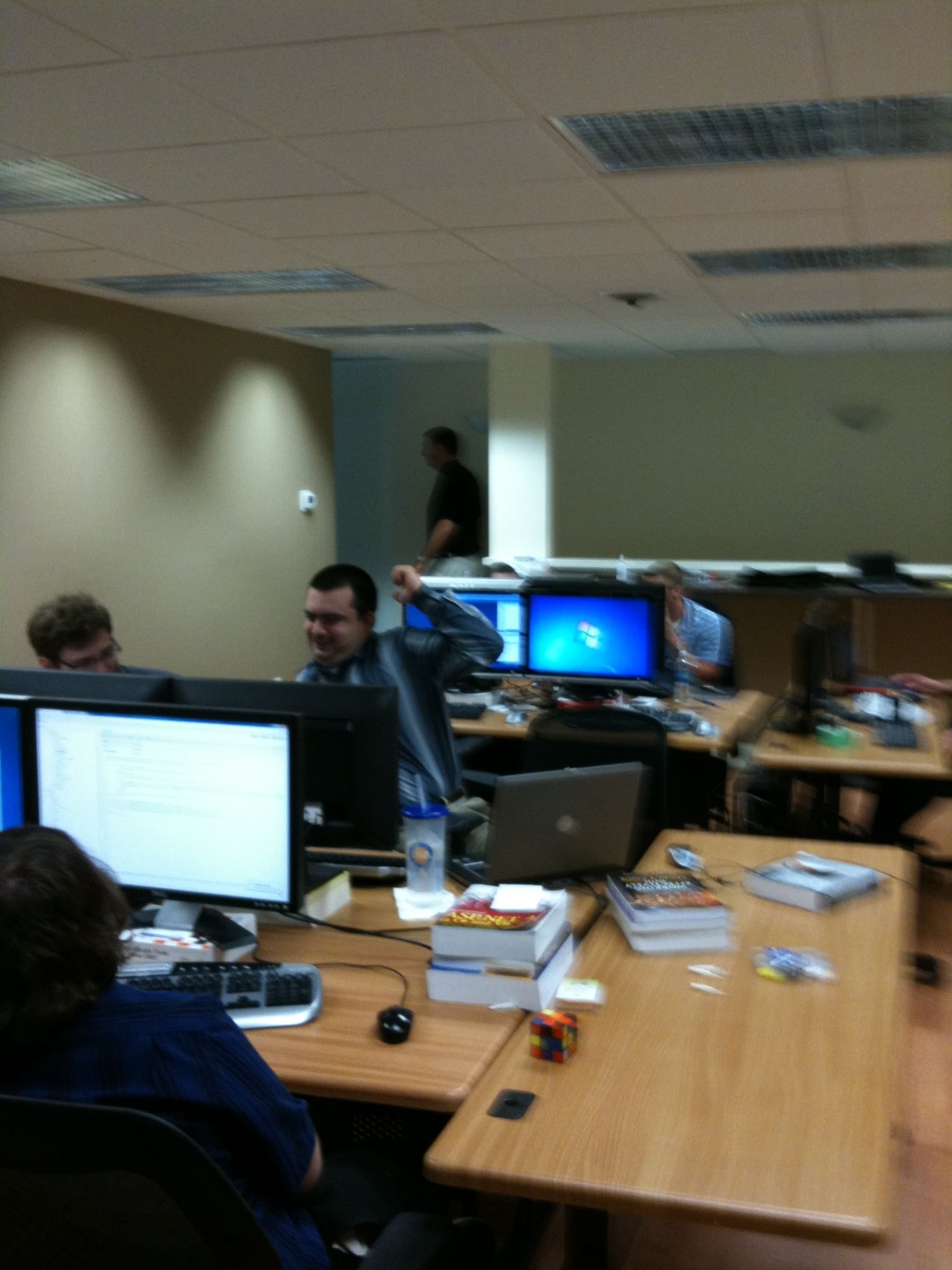
Notice the close proximity and lots of pair programming. No walls and everyone is constantly able to share information and ideas.
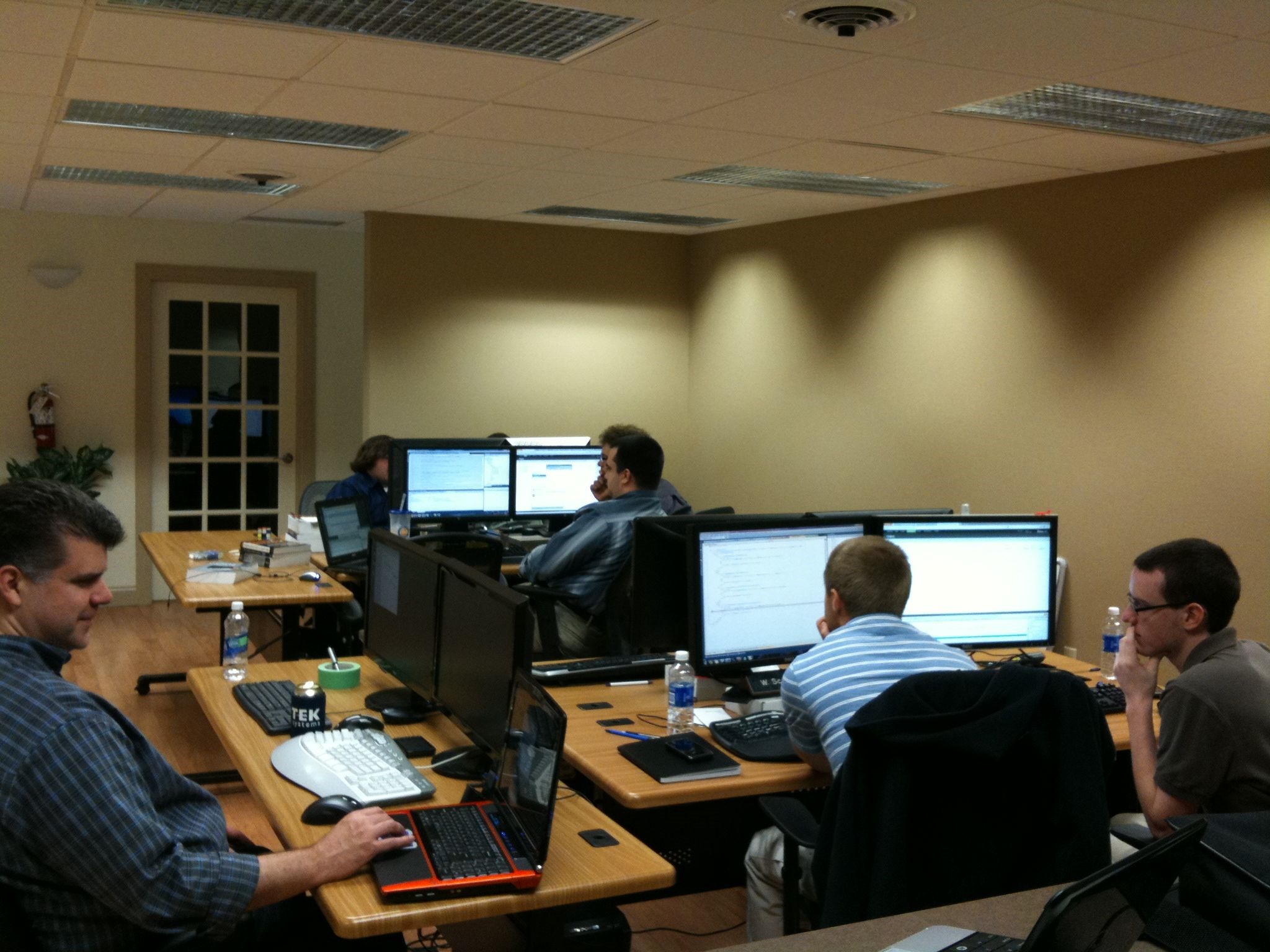
In these buildings:

Yep those two buildings are what I like to call “The NimblePlex”. NimblePros shifted around quite a bit between these two buildings over the years. I had 4 different offices while I was in those buildings! Long stories to explain all of those!
Now I am using this desk:
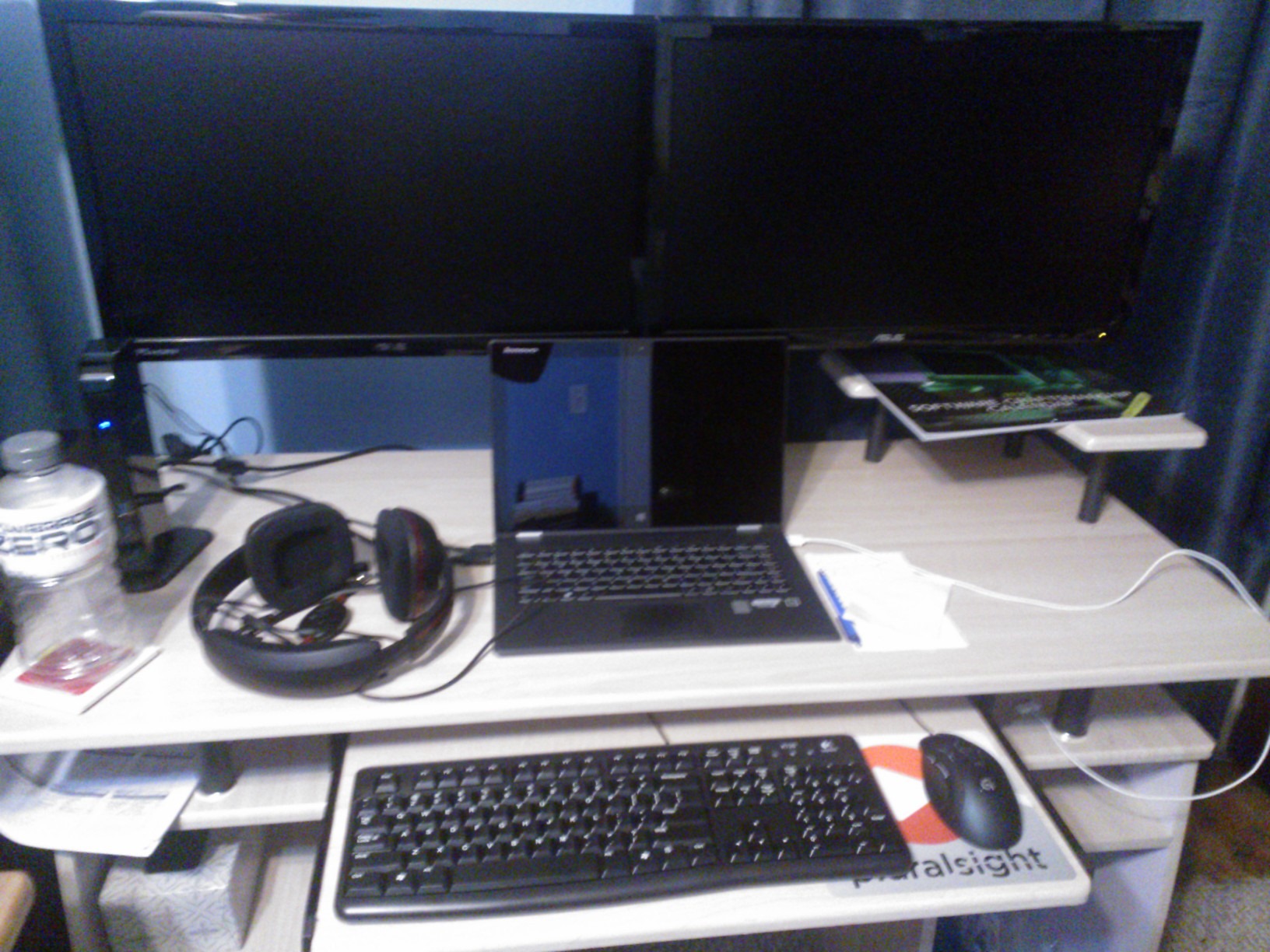
It works pretty well for me. I made sure to get one that was for work and one that wasn’t. I am currently seated about 5-6 feet to the left of where I sit there. That’s important to me, having that separation.
For anyone paying attention to these pictures, I’ve got a Software Craftsmanship calendar on my desk, a Pluralsight mouse pad, an ASP Alliance coaster, and that’s a stack of books in the reflection. Can you identify the books? If you have a copy of the Software Craftsmanship Calendar, you might recognize three stars from this year’s calendar!
I did not expect to be working from home at this point, but it’s been interesting. I am able to have much better lunches than I did before. I now take 20 minutes to prepare and eat a salad most days, and I am watching Star Trek on Netflix during that time. I take a full hour for my lunch break though, so I have time to finish the episode while running on a treadmill. It’s amazing how much more energy I’ve got in the afternoon with this routine. I cannot recommend it enough. In fact, if I do move back into an office, I am looking into having a treadmill there!
Going Forward
I am never one who is without goals. If anything, I would say that I have more goals than I could possibly achieve. I’ve always thought that a good thing, since it gives me direction.
I am working on and planning some Pluralsight courses, which hopefully will be out soon. I’ll keep you posted.
As I’m sure you figured out, I don’t mind working remotely. In fact, it’s got some benefits and has been going well. My next goal at Clear Measure (aside from the success of the company and the projects I work on) is to build up an extremely talented team around me. I’ve started that process already, and Rich Hildebrand recently joined our team up here.
CodeMash 2.0.1.4 started as one of the coldest CodeMashes on record. On Monday, during the set up time for the event, the temperature in Sandusky dropped below negative ten degrees and the wind chill kept it feeling much colder. It was severely lacking in snow, but the cold was enough to cancel many of the Tuesday precompiler sessions whose speakers were not able to arrive at CodeMash on time to run the workshops.
The conference has grown to the point where it now has two initial days of workshops on Tuesday and Wednesday. Then the conference has two normal conference days filled with sessions. Considering that all of my favorite content is always the precompiler workshops on the first two days, I would love to see the conference have workshops through the entire event. I am usually one of the precompiler workshops speakers, so I might be a bit opinionated on that. From another viewpoint though, since I am one of the speakers during that time, I am often wishing I could attend workshops during the same time as mine! I love running the workshops though, so I gladly give up the other ones. I just need to figure out how to be in two plaes at once (future goal).
CodeMash Precompiler Workshop Details
For those who attended my and Steve’s Software Craftsmanship precompiler workshops on Wednesday, the weather was much more forgiving. Most people had arrived by that point, which meant that our attendance was also good. This was the fifth year that Steve and I had run this precompiler event at CodeMash. We adjust, change, and update the workshop every year. In the past, we had to teach a lot more about the basics of unit testing, but now more people have at least some knowledge of unit testing.
Over the years of doing this workshop here (and similar ones elsewhere), we've found a lot of good techniques and exercises for working with the attendees of the event. We try and experiement with lots of exercises and katas at conferences, events, and user groups, because we're looking for great ways to teach these types of events. When we run them, we are always trying to make sure that most of the event is spent coding. Through this, our goal is not to give an exercise to the attendees. Our goal is to teach them how they can continue their exercising and learning after they leave the event. That's our goal.
We use a few types of exercises: gateway exercises designed to teach you how to practice, guided exercises leading you down a path slowly with steps for freedom along the way, and open-ended exercises giving great freedom and possibilities in final implementations. As part of the open-ended exercise, we often attempt to use that as a plane up which to build a specific type of implementation. We will choose a principle or a pattern and use this plane as an area in which to practice following the principle or pattern. This shows the students how they can leverage programming exercises as places to learn new principles and patterns.
Beginning Software Craftsmanship Workshop
In the morning, we start out our session for beginners just learning software craftmanship. This course is for people familiar with programming (using any language) that want to learn more about software craftsmanship and work on programming exercises with their peers.
As we do every year, I started off the discussion by explaining software craftsmanship and giving an introduction to its concepts. I explain the software craftsmanship manifesto, what it means to developers, and how it relates to the agile manifest. Through this talk, I always make sure to emphasize the importance and reasons for deliberately practicing. As the entire audience will agree, when under a deadline they jump back to their poor practices they know aren't the best. Practice is how we drill ourselves to handle the situation in our own desired way. I make sure that the audience knows as well as discussing and working with others. If I can encourage more people to attend and start software craftsmanship groups, I would consider this talk a great success.
Introduction to Software Craftsmanship Slides
Once we had the reason for why we're all here, we start getting into some of the meat of the workshop. Steve then presented his well-honed talk on software principles. Most of them are designed for object oriented programming, but many are applicable to nearly any language or paradigm. Along the way he of course will cover SOLID, and the slides all contain images from our Software Craftsmanship Calendar. The 2014 edition of the Telerik Software Craftsmanship calendar is out, and everyone at CodeMash received a copy of the calendar.
Software Development Principles Slides
While Steve is wrapping up the end of his presentation, I start passing around sheets of paper (yes, real paper) containing a printing of the first exercise we'll be doing. For our first exercise, we were doing FizzBuzz an exercise that is simple enough that it gets people used to the idea of practicing. This is our gateway exercise. We use this to make sure that everyone is set up with their tools. As long as their setup allows them to write code and run tests, it should be good enough. We include some extra credit with these, so that most people can at least get close to finishing the first part of our exercises. Some people will finish the extra credit, which means that we can have nearly everyone reach a stage of accomplishment.
We also ask that the entire group pair up, so that they can work on the exercise with others. This accomplishes quite a few things, including helping those who don't have a computer with them.
FizzBuzz Programming Exercise
Interrupting everyone's coding is always a challenge, but I make sure to do it nicely. A microphone helps with this! Now that everyone is set up, we take a break from the coding to talk about practices that we promote to the group. The first of these practices is testing. As is still the case, most people are testing or at least familiar with the practice. As a result, I cover this topic briefly making sure to emphasize the different types and their importance. There are still many groups forced to write integration tests instead of unit tests for example. We discuss how to avoid that situation in the afternoon when we discuss more good practices.
The second practice that we discuss is continuous integration, however, since we don't have the time to set these up on everyone's computer, we only discuss this briefly and suggest that people try them.
The third practice is pairing, a practice that we've already had the group start in their first exercise. Not only do I cover the methods of pairing, but I point out all of the good pairing practices that everyone was using without thinking. I then point out the importance of changing partners and typists frequently. In their first programming exercise, very few people change who is typing. Since pairing is such a hard activity, we also make sure to cover all of the things that you can do to improve your pairing by changing the environment in which you're working.
Software Craftsmanship Practices Slides
The String Calculator is a guided exercise in which you only read one step at a time. Each step has parts to it, but you do them one at a time. This follows the normal scenario of receiving your requirements a piece at a time. It also keeps you following a plan and gives you a great chance to follow YAGNI. The students do well with this, and it's an exercise that does very well on paper, since you can fold the sheet over the future steps.
String Calculator Programming Exercise
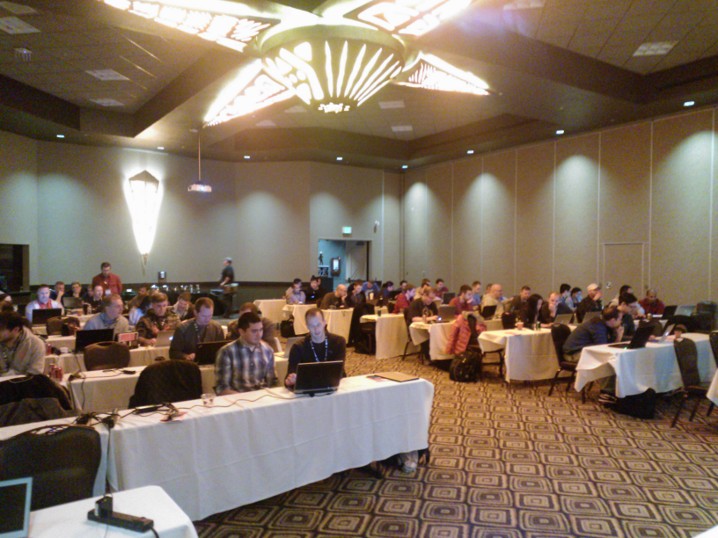
Intermediate Software Craftsmanship Agenda Workshop
After lunch, we started our second workshop. This one is a half-day workshop designed for people who attend the morning workshop or are already somewhat familiar with software craftsmanship, deliberate practice, or who just couldn't fit the morning session into their schedule.
Steve starts off the talking in the afternoon discussing design patterns. Steve is an expert in design patterns and refactoring, so he's a great person to present this workshop with. Steve covers a lot of design patterns in this talk. You'll notice that a lot of these patterns have overlap and many of them stem directly from one or more of the principles mentioned in Steve's morning talk. This is not a session to miss!
Design Patterns Slides
Once we're done with the design pattersn talk, we make sure that we start everyone on an open-ended exercise. This year's was the greed dice game scoring exercise where you create code that will score the results of one roll in the greed dice game. It's a simple exercise, but can get a bit unwieldy if you're not refactoring or implementing a good design. We don't suggest that anyone try any specific design for their first attempt.
Greed Game Programming Exercise
We follow up this programming with even more programming practices to follow. I do this talk, which is about more advanced types of testing using mocks, fakes, stubs, etc. We want to make sure everyone knows how to do these. We sometimes do an exercise that can leverage these skills, but we did not this year. We instead showed a quick demo of doing this with a logging system that logs to the file system.
Advanced Testing Practices Slides
Back to Greed again for the final exercise of the day. We finish out the workshop asking everyone to program the Greed game scorer again. This gives the students the chance to attempt a more complex solution to the problem this time around. We had everyone attempt to implement a Rules Engine for the second attempt, which will allow them to follow the Open/Closed Principle.

Overall we received a lot of wonderful feedback from our students, and I hope that everyone who attended goes on to continue doing what we taught in that workshop. Thank you all for attending. Thanks CodeMash for putting on a wonderful event and inviting me and Steve to run one of your precompiler workshops. It is always a fantastic time! I look forward to seeing more of you there in the future. Have a great 2014!







